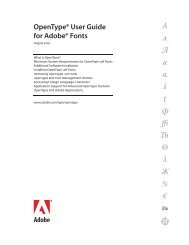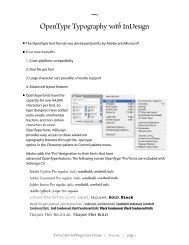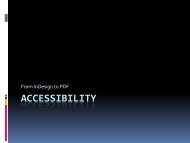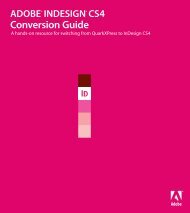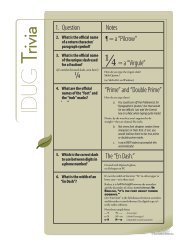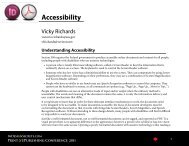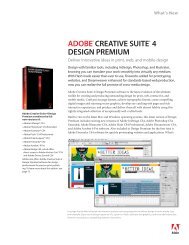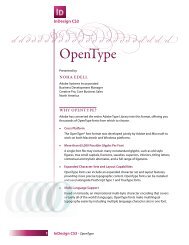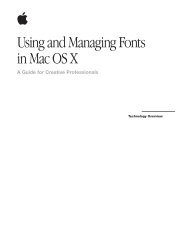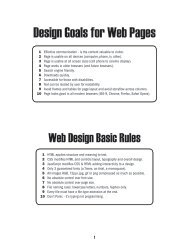Quark to InDesignCS3 Conversion Guide - InDesign User Group
Quark to InDesignCS3 Conversion Guide - InDesign User Group
Quark to InDesignCS3 Conversion Guide - InDesign User Group
Create successful ePaper yourself
Turn your PDF publications into a flip-book with our unique Google optimized e-Paper software.
Invoke Quick Apply and type<br />
the first few letters in a style<br />
name <strong>to</strong> quickly locate and<br />
apply a style.<br />
Style. The Headline style is applied <strong>to</strong><br />
the first paragraph, the Byline style is<br />
applied <strong>to</strong> the second paragraph, and<br />
the Body Text style is applied <strong>to</strong> the<br />
remaining paragraphs.<br />
Undo changes when modifying a<br />
style that’s based on another style.<br />
If you make changes <strong>to</strong> a paragraph<br />
style that’s based on another style,<br />
click Reset To Base <strong>to</strong> res<strong>to</strong>re the settings<br />
of the “child” style <strong>to</strong> those of<br />
the “parent” style.<br />
Quickly apply any character or<br />
paragraph style. The Quick Apply<br />
feature lets you quickly find and<br />
apply character and paragraph styles.<br />
Quick Apply has been enhanced in<br />
<strong>InDesign</strong> CS3 and allows you <strong>to</strong> apply<br />
features, such as menu commands,<br />
text variables, and scripts, all while<br />
keeping your hands on the keyboard.<br />
To open the Quick Apply panel,<br />
choose Edit > Quick Apply, or press<br />
Command+Return in Mac OS or<br />
Ctrl+Enter in Windows. You can also<br />
open Quick Apply by clicking the<br />
Quick Apply icon in the Control<br />
panel. When the panel is displayed,<br />
type the first letter or letters of a style<br />
<strong>to</strong> select it, and then press Return or<br />
Enter <strong>to</strong> apply it and close the panel.<br />
The Quick Apply feature also works<br />
with object styles.<br />
Support for styles in Word documents.<br />
<strong>InDesign</strong> offers powerful<br />
controls for handling styles in<br />
imported Word documents. For<br />
more information, see page 39.<br />
what are nested styles in <strong>InDesign</strong>?<br />
A nested style is a character style<br />
that’s saved within a paragraph style<br />
and applies character-level formatting<br />
<strong>to</strong> a range of text. You can set<br />
up two or more nested styles <strong>to</strong><br />
work sequentially, with one nested<br />
style taking over where the previous<br />
one ends. Nested style looping, new<br />
in <strong>InDesign</strong> CS3, lets you repeat a<br />
sequence of nested styles through<br />
the end of a paragraph.<br />
Nested styles are especially useful<br />
for creating run-in headings at<br />
the beginning of a paragraph. For<br />
example, you can apply one character<br />
style <strong>to</strong> the first letter in a paragraph<br />
(such as, a drop cap) and another<br />
character style that takes effect<br />
through the first colon (:). For each<br />
nested style, you can define a character<br />
that ends the style, such as a tab<br />
character or the end of a word.<br />
To create a nested style, you first<br />
create one or more character styles.<br />
Then choose New Paragraph Style<br />
from the Paragraph Styles panel<br />
menu, and specify the attributes of<br />
that style. In the Drop Caps And<br />
Nested Styles pane, click New Nested<br />
Style. In the Nested Styles area, select<br />
a character style from the pop-up<br />
menu, and then click the area <strong>to</strong> the<br />
right of the character style and<br />
choose Through or Up To. Choosing<br />
Through includes the character you<br />
specify in the rightmost column;<br />
choosing Up To formats only the<br />
text that precedes this character. In<br />
the rightmost column, choose an<br />
option from the menu, or type a<br />
character. This setting determines<br />
where the character formatting<br />
ends. Click the area <strong>to</strong> the left of<br />
the rightmost column, and specify<br />
how many instances of the character<br />
are required.<br />
All About Styles 55







